Intel Z68 Chipset & Smart Response Technology (SSD Caching) Review
by Anand Lal Shimpi on May 11, 2011 2:34 AM ESTAnandTech Storage Bench 2011
With the hand timed real world tests out of the way, I wanted to do a better job of summarizing the performance benefit of Intel's SRT using our Storage Bench 2011 suite. Remember that the first time anything is ever encountered it won't be cached and even then, not all operations afterwards will be cached. Data can also be evicted out of the cache depending on other demands. As a result, overall performance looks more like a doubling of standalone HDD performance rather than the multi-x increase we see from moving entirely to an SSD.
Heavy 2011—Background
Last year we introduced our AnandTech Storage Bench, a suite of benchmarks that took traces of real OS/application usage and played them back in a repeatable manner. I assembled the traces myself out of frustration with the majority of what we have today in terms of SSD benchmarks.
Although the AnandTech Storage Bench tests did a good job of characterizing SSD performance, they weren't stressful enough. All of the tests performed less than 10GB of reads/writes and typically involved only 4GB of writes specifically. That's not even enough exceed the spare area on most SSDs. Most canned SSD benchmarks don't even come close to writing a single gigabyte of data, but that doesn't mean that simply writing 4GB is acceptable.
Originally I kept the benchmarks short enough that they wouldn't be a burden to run (~30 minutes) but long enough that they were representative of what a power user might do with their system.
Not too long ago I tweeted that I had created what I referred to as the Mother of All SSD Benchmarks (MOASB). Rather than only writing 4GB of data to the drive, this benchmark writes 106.32GB. It's the load you'd put on a drive after nearly two weeks of constant usage. And it takes a *long* time to run.
First, some details:
1) The MOASB, officially called AnandTech Storage Bench 2011—Heavy Workload, mainly focuses on the times when your I/O activity is the highest. There is a lot of downloading and application installing that happens during the course of this test. My thinking was that it's during application installs, file copies, downloading and multitasking with all of this that you can really notice performance differences between drives.
2) I tried to cover as many bases as possible with the software I incorporated into this test. There's a lot of photo editing in Photoshop, HTML editing in Dreamweaver, web browsing, game playing/level loading (Starcraft II & WoW are both a part of the test) as well as general use stuff (application installing, virus scanning). I included a large amount of email downloading, document creation and editing as well. To top it all off I even use Visual Studio 2008 to build Chromium during the test.
The test has 2,168,893 read operations and 1,783,447 write operations. The IO breakdown is as follows:
| AnandTech Storage Bench 2011—Heavy Workload IO Breakdown | ||||
| IO Size | % of Total | |||
| 4KB | 28% | |||
| 16KB | 10% | |||
| 32KB | 10% | |||
| 64KB | 4% | |||
Only 42% of all operations are sequential, the rest range from pseudo to fully random (with most falling in the pseudo-random category). Average queue depth is 4.625 IOs, with 59% of operations taking place in an IO queue of 1.
Many of you have asked for a better way to really characterize performance. Simply looking at IOPS doesn't really say much. As a result I'm going to be presenting Storage Bench 2011 data in a slightly different way. We'll have performance represented as Average MB/s, with higher numbers being better. At the same time I'll be reporting how long the SSD was busy while running this test. These disk busy graphs will show you exactly how much time was shaved off by using a faster drive vs. a slower one during the course of this test. Finally, I will also break out performance into reads, writes and combined. The reason I do this is to help balance out the fact that this test is unusually write intensive, which can often hide the benefits of a drive with good read performance.
There's also a new light workload for 2011. This is a far more reasonable, typical every day use case benchmark. Lots of web browsing, photo editing (but with a greater focus on photo consumption), video playback as well as some application installs and gaming. This test isn't nearly as write intensive as the MOASB but it's still multiple times more write intensive than what we were running last year.
As always I don't believe that these two benchmarks alone are enough to characterize the performance of a drive, but hopefully along with the rest of our tests they will help provide a better idea.
The testbed for Storage Bench 2011 has changed as well. We're now using a Sandy Bridge platform with full 6Gbps support for these tests. All of the older tests are still run on our X58 platform.
AnandTech Storage Bench 2011—Heavy Workload
We'll start out by looking at average data rate throughout our new heavy workload test:
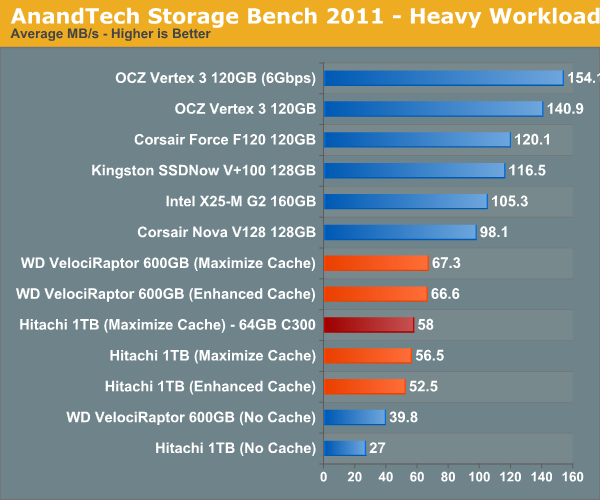
For this comparison I used two hard drives: 1) a Hitachi 7200RPM 1TB drive from 2008 and 2) a 600GB Western Digital VelociRaptor. The Hitachi 1TB is a good large, but aging drive, while the 600GB VR is a great example of a very high end spinning disk. With a modest 20GB cache enabled, the 3+ year old Hitachi drive is easily 41% faster than the VelociRaptor. We're still not into dedicated SSD territory, but the improvement is significant.
I also tried swapping the cache drive out with a Crucial RealSSD C300 (64GB). Performance went up a bit but not much. You'll notice that average read speed got the biggest boost from the C300 as a cache drive since it does have better sequential read performance. Overall I am impressed with Intel's SSD 311, I just wish the drive were a little bigger.
The breakdown of reads vs. writes tells us more of what's going on:
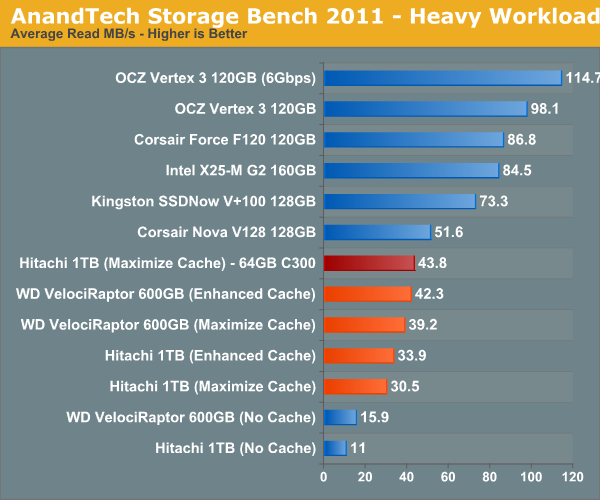
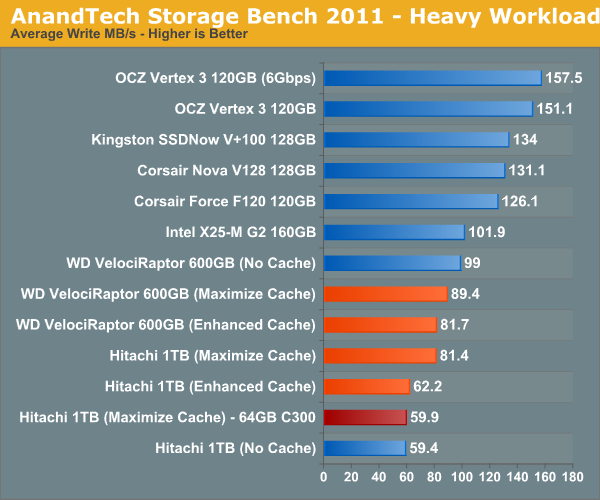
This isn't too unusual—pure write performance is actually better with the cache disabled than with it enabled. The SSD 311 has a good write speed for its capacity/channel configuration, but so does the VelociRaptor. Overall performance is still better with the cache enabled, but it's worth keeping in mind if you are using a particularly sluggish SSD with a hard drive that has very good sequential write performance.
The next three charts just represent the same data, but in a different manner. Instead of looking at average data rate, we're looking at how long the disk was busy for during this entire test. Note that disk busy time excludes any and all idles, this is just how long the SSD was busy doing something:
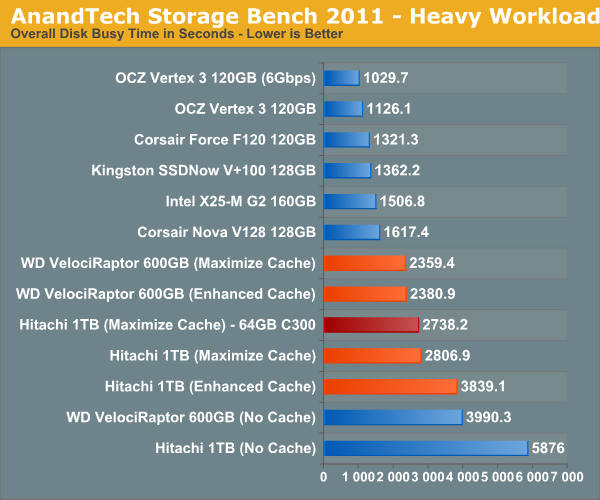
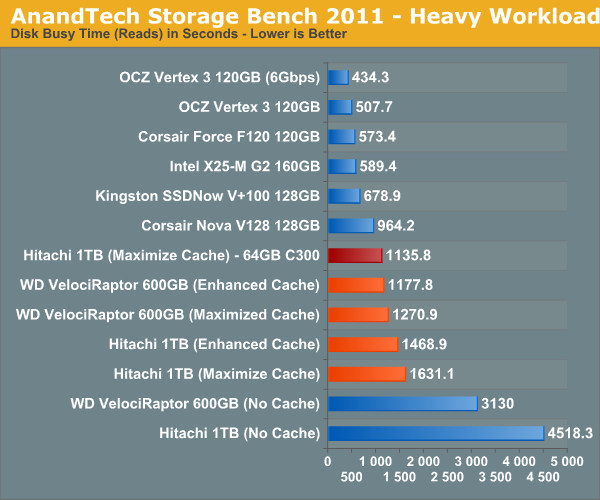











106 Comments
View All Comments
µBits - Monday, July 11, 2011 - link
http://download.intel.com/support/motherboards/des...System Requirements:
For a system to support Intel Smart Response Technology it must have the following:
codedivine - Wednesday, May 11, 2011 - link
I am interested in using Linux and I am wondering about various things:1. Will it work under Linux? Can I configure it from Linux?
2. Is it file system dependant? I guess it is not.
3. Whether it will work on multi-OS machines. For example, what happens if I dual boot Windows and Linux?
Unrelated to Linux is, does this scheme get confused by say using lots of VMs?
Penti - Wednesday, May 11, 2011 - link
No, so called fake raid (software raid) that the chipset/drivers supports do never work in Linux. RST do not work under other OS's then Windows. Mac and Linux will have to use the built in software raid rather then the none existing driversbased one. And will lack all support for SSD caching.VMs usually write to a virtual hard drive (file) that saves the data to the disk. That should be absolutely fine.
Mulberry - Saturday, May 21, 2011 - link
but to the question on dual booting:Can you dual boot eg. Win XP and Win 7?
headhunter00 - Sunday, August 7, 2011 - link
well, you can always set the root partition on the ssd, by creating custom partitions during installation, and set the resource hogging partitions such as /var and /home on your hdd. this way, all the binaries and libraries load from the hdd. if you don't have enough space on your hdd to do that either, then you are out of luck. thats the closest you can get to ssd caching in linux. ofcourse there is a patch for the kernel to do ssd caching natively, but its pretty outdated and probably not compatible with your hardware. to do ssd-caching in windows with linux, you have to preserve some space on ssd to do so.MonkeyPaw - Wednesday, May 11, 2011 - link
The virtue interface is awful. Looks like the ugly tree fell on that android girl.sunbear - Wednesday, May 11, 2011 - link
Consumer nases (readynas, qnap, etc) could really benefit from this. Flashcache (http://planet.admon.org/flashcache-caching-data-in... released by facebook also looks interesting.fitten - Wednesday, May 11, 2011 - link
Can you have an SSD as your boot drive, then a large HDD (typical configuration... OS/apps on SSD, data/etc on HDD) and then have yet-another SSD enabled with SRT for caching the HDD? Seems like the best of both worlds (other than cost).swhitton - Wednesday, May 11, 2011 - link
I reckon that setup would almost certainly work fine.What I'm wondering is whether you could use a single SSD partitioned so that part of it was a boot drive and the other part was a cache for a HDD. Such a setup would solve the problem of the 120gb SSD not being quite the right size for any particular purpose.
A 60-80gb partition with Windows and apps on it and the remaining space used as a cache. This would avoid the problem of having to symbolic link Steam games and so forth, while also not requiring you to buy two SSDs in order to have a boot drive and a cache drive.
Anand did mention that a cache drive could be partitioned so that only part of it needed to be used as a cache. Just not sure if there would be any issues that might arise with using the remaining partition as a boot drive.
Thoughts anyone?
y2kBug - Wednesday, May 11, 2011 - link
Here is a quote from vr-zone.com’s review (http://vr-zone.com/articles/first-look-msi-z68a-gd... ) on SRT: “All existing partitions on the SSD must be deleted before it can be used as a cache”. This makes me believe that using oneSSD for dual purposes (boot drive and SRT at the same time) is not possible. I really want to hear Anand’s last word on this.